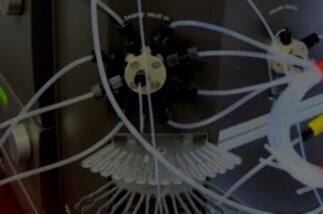
Maintenance & Repair for Agilent 1100 HPLC Systems
You rely on your equipment. Your equipment should rely on ATG.
Agilent HPLC systems are widely known for their performance and reliability, but nothing is perfect and any instrument is prone to technical issues – especially if not properly maintained. Analytical Technologies Group specializes in the repair and maintenance of Agilent 1100 series HPLC systems. Why trust ATG for your service needs? We stock replacement parts to minimize your downtime, and our service engineers all maintain expert knowledge on Agilent 1100 HPLC systems due to it being one of only a few product lines we focus on.
See for yourself why over 4,000 customers at over 1,000 companies have trust ATG to keep their labs operating smoothly.
Tips for keeping your Agilent 1100 HPLC in good working order:
Keep your solvent bottles at a higher level than the capillary pump.
Always change your solvents regularly to ensure that there is no algae or other microbial growth which could cause contamination and clog the solvent inlet filter. Use sterile, amber solvent bottles.
To avoid clogging issues, always filter your solvents before use. It is recommended that you use filters with a pore size no larger than 0.4 µm.
Avoid using solvents which are corrosive to steel.
Always respect the minimum recommended flow setpoints. These are 100 µl / min when in normal mode, 10 µl / min when in micro mode with a 100 µl flow sensor, or 100 µl / min when in micro mode with a 20 µl flow sensor.
When you replace a part, clean it with acetone. This is especially true for capillaries.
If you bend a capillary, ensure that it is not bent in a shape which would have less than a 4 cm diameter.
Avoid the use of alkaline solutions of pH > 8.5, which can degrade fused silica capillaries.
Set the upper pressure limit to 50 bar higher than the typical operating pressure. This will help avoid damage to the diode array detector cell.
As with any instrument, keep the instrument itself and area around it free from dust and dirt.
Having technical problems with your Agilent 1100?
Fast Response
We provide very prompt responses to customers within one business day.
Fast Turnaround
Our field service engineers are expediently dispatched across North America & Europe to fulfill your service request.
Expert Staff
ATG’s highly trained, highly skilled staff ensure your instruments remain in optimal condition.
Replacement Parts Stocked
To minimize instrument downtime, we stock virtually all parts for the systems in which we specialize.
Agilent 1100 HPLC Troubleshooting Tips:
Many issues, including pressure issues and detector noise, may be caused by a dirty or system or air in the system. Check your buffers and inlet filters to ensure they are clean. Check to ensure there are no leaks in the system. Purge the system thoroughly, first in purge mode, then with a pressure applied.
If the system pressure is abnormally low, check the system for leaks. Check that your %Ripple is not too high (it should be 2% or less). If you have not used the system for more than a day, you may need to re-purge the system. It could also be a symptom of dirty inlet filters, which should be checked and cleaned / replaced if necessary.
System pressure which is too high almost always indicates a clog or blockage. It could be that the column has become clogged, in which case it should be replaced or backflushed. Check to ensure that capillaries are not crushed or kinked. Perform a pump purge at 1000 µl / min using pure water; if pressure is over 10 bar, the electromagnetic proportional valve (EPMV) filter needs replacing. If bypassing the sampler injection valve lowers the pressure significantly, backflush or replace the needle seat and sample loop capillary, replace the needle and injection valve rotor seal, and clean the stator head.
If the EPMV fails to initialize, there is likely a blockage or restriction. Ensure the solvent channels are purged. Perform a pump purge at 1000 µl / min using pure water; if pressure is over 10 bar, the EPMV filter needs replacing. Check the flow path from the damper outlet to the EPMV, and from the EPMV to the flow sensor for blockages or restrictions. If it cannot be remedied, you may need to replace the EPMV assembly.
If the system cannot generate enough pressure for reliable flow control when in micro mode, you may need to add an additional capillary after the pump to generate more pressure.
If your pump is not performing well, perform a pump leak test to see if there are internal problems with the pump.
A peak fronting or tailing is usually a signal that your column is in need of replacement, but it could also be due to capillary issues which may cause excessive dead volume. Check for leaks, ensure all connections are made properly, and ensure no capillaries are crushed or kinked.
Baseline drift could be caused by the diode array detector or the LC system. If you remove the flow cell from the DAD and the signal does not improve, you may need to replace the lamp, or the issue could be caused by an unstable operating environment (temperature changes, etc.) If the DAD is not the issue, reinstall the mixer if it was removed. The issue could also be due to a dirty or defective flow cell, a column which is reaching the end of its life, or mixing noise which occurs when pumping mobile phase from two channels.
If your problems cannot be resolved, your HPLC may require professional maintenance. Contact ATG for prompt, qualified service.

